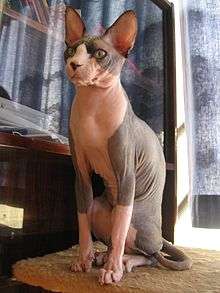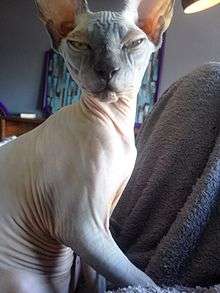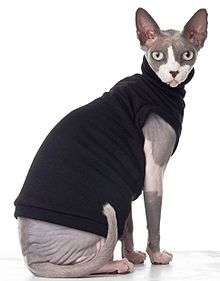Sphynx cat
| Sphynx | |
|---|---|
 | |
| Origin | Ontario, Canada |
| Breed standards | |
| CFA | standard |
| FIFe | standard |
| TICA | standard |
| AACE | standard |
| ACFA/CAA | standard |
| CCA-AFC | standard |
| Domestic cat (Felis catus) | |
The Sphynx is a hairless breed of cat developed through selective breeding starting in the 1960s,[1] known for its lack of coat (fur), though it's not truly hairless. The skin should have the texture of chamois, as it has fine hairs. Whiskers may be present, either whole or broken, or may be totally absent. Their skin is the color that their fur would be, and all the usual cat markings (solid, point, van, tabby, tortie, etc.) may be found on Sphynx skin. Because they have no coat, they lose more body heat than coated cats. This makes them warm to the touch as well as heat-seeking.
Breed standards
- Wedge-shaped heads with prominent cheekbones
- Large, lemon-shaped eyes
- Very large ears with no hair on inside, but soft down on outside base
- Well-muscled, powerful neck of medium length
- Medium length torso, barrel-chested, and full, round abdomen, sometimes called a pot belly
- Paw pads thicker than other cats, giving the appearance of walking on cushions
- Whiplike, tapering tail from body to tip, sometimes with a puff of fur on the tip, like a lion
- Muscular body[2]
Behavior

Sphynxes are known for their extroverted behavior. They display a high level of energy, intelligence, curiosity, and affection for their owners.[4] They are one of the more dog-like breeds of cats, frequently greeting their owners at the door and friendly when meeting strangers.
History of the cat breed
 |
Video of a Sphynx cat
 (Duration: 56 seconds) |
Although hairless cats have been reported throughout history, breeders in Europe have been working on the Sphynx breed since the early 1960s. Two different sets of hairless felines discovered in North America in the 1970s provided the foundation cats for that which was shaped into the existing Sphynx breed.
The contemporary breed of Sphynx, also known as the Canadian Sphynx, is distinct from the Russian Sphynx breeds like Peterbald and Don Sphynx.
The current American and European Sphynx breed is descended from two lines of natural mutations:
- Dermis and Epidermis (1975) from the Pearsons of Wadena, Minnesota, USA.
- Bambi, Punkie, and Paloma (1978) found in Toronto, Canada, and raised by Shirley Smith.[5]
The Canadian Sphynx breed was started in 1966, in Toronto when a hairless kitten named Prune was born to a black and white domestic shorthair queen (Elizabeth). The kitten was mated with its mother (backcrossing), which produced one more naked kitten. Together with a few naked kittens found later it founded the first attempt to create a hairless breed.
After purchasing these cats in 1966 and initially referring to them as "Moonstones" and "Canadian Hairless," Mr. Ridyadh Bawa, a science graduate of the University of Toronto, combined efforts with his mother Yania, a long time Siamese breeder, and the Tenhoves (Kees and Rita) to develop a breed of cats which was subsequently renamed as "Sphynx". It is apparent that the Bawas and the Tenhoves were the first individuals able to determine the autosomal recessive nature of the Sphynx gene for hairlessness while also being successful in transforming this knowledge into a successful breeding program with kittens which were eventually capable of reproducing.
The Tenhoves were initially able to get the breed Provisional showing status through the Cat Fanciers' Association (CFA) but ultimately had the status revoked in 1971 when it was felt by the CFA Board that the breed lacked both a consistent standard and an adequately broad gene pool.
The first noted naturally occurring foundation Sphynx originated at the Wadena, Minnesota farm of Milt and Ethelyn Pearson, who identified hairless kittens occurring in several litters of their Domestic Shorthair (DSH) barn cats in the mid-1970s. Two hairless female kittens born in 1975 and 1976, Epidermis and Dermis, became an important part of the Sphynx breeding program and further hairless cats were found in Texas, Arkansas, and Minnesota. Modern Sphynx, therefore, trace their origins to the second Canadian bloodline and to the Minnesota cats.
The first breeders had rather vague ideas about Sphynx genetics and faced a number of problems. The genetic pool was very limited and many kittens died. There was also a problem with many of the females suffering convulsions. The last two descendants of Prune, a brother-sister pair, were sent to the Netherlands in the 1970s, but the male was uninterested in mating and the female conceived only once, but lost the litter.
The breeding program of these pioneers withered after this time with the final traceable Bawa line cats : Mewsi-Kal Johnny, Mewsi-Kal Starsky (Hugo Hernandez, the Netherlands) and Prune's Epidermis (David Mare, California), were unable to produce sustainable lines prior to being altered in the early 1980s.
In 1978 and 1980, two further hairless female kittens were found in Toronto and were sent to the Netherlands to be bred with Prune's last surviving male descendent. One female conceived, but she also lost the litter. By then, the one remaining male had been neutered, never having been interested in mating with any of the females. As a result, no modern Sphynx cats are traceable to Prune. With no male Sphynxes, breeders instead used sparsely-furred, Devon Rex studs.
In the early stages of the breed crosses with Devon Rex were used, but later this crossing was frowned upon because it caused health problems. Now the Canadian Sphynx is a breed with a sound genetic pool. Outcrossing is still permitted using guidelines set down in the "standards" from each Feline Association around the globe.
Breeding
.jpg)
Other hairless breeds might have body shapes or temperaments that differ from those described above. There are, for example, new hairless breeds, including the Don Sphynx and the Peterbald from Russia, which arose from their own spontaneous mutations. The standard for the Sphynx differs between cat associations such as TICA, FIFE and CFA.
In 2010, DNA analysis confirmed that Sphynx hairlessness was produced by an allele of the same gene that produces the Devon Rex (re), with the Sphynx allele being incompletely dominant over the Devon allele and both recessive to the wild type. However a different genetic symbol (hr) is given to the Sphynx gene and it is more likely that these are different genes interacting with each other. The only allowable outcross breeds in the CFA are now the American Shorthair and Domestic Shorthair. Other associations may vary and the Russian Blue is a permitted outcross in the GCCF. In Europe, mainly Devon Rex has been used for outcrosses.
In 1999 SGC Apophis Nordstrom of Classical Cats won the TICA International Alter of the Year. In 2006 SGC Classical Cats Valentino] won the TICA International Cat of the year. In the Cat Fancier's Association, GC, RW, NW Majikmoon Will Silver With Age was Cat of the Year for 2006. The following year, GC, RW, NW Enchantedlair NWA Cornflake Girl was Kitten of the Year. These awards are handed out for the highest scoring cats, across all breeds during the current show seasons. But in the end the Sphynx cat remain one of the rarest cats.
Care

Though Sphynx cats lack a coat to shed or groom, they are not maintenance-free. Body oils, which would normally be absorbed by the hair, tend to build up on the skin.
As a result, regular bathing is usually necessary weekly or bi-weekly.[6] Care should be taken to limit the Sphynx cat's exposure to outdoor sunlight at length, as they can develop sunburn and skin damage similar to that of humans. In general, Sphynx cats should never be allowed outdoors unattended, as they have limited means to conserve body heat when it is cold. In some climates, owners provide coats or other clothing in the winter to help them conserve body heat.[7]
While they lack much of the fur of other cat breeds Sphynx cats are not necessarily hypoallergenic. Allergies to cats are triggered by a protein called Fel d1, not cat hair itself. Fel d1 is a protein primarily found in cat saliva and sebaceous glands. Those with cat allergies may react worse to direct contact with Sphynx cats than other breeds. However, conflicting reports of some people successfully tolerating Sphynx cats also exist.[8] These positive reports may be cases of desensitizing, wherein the "hairless" cat gave the owner optimism to try to own a cat, eventually leading to the positive situation of their own adaptation.
Sphynx cats can also have more ear wax than most hairy domestic cats because they have little to no hair in their ears to catch and protect them from a build up of impurities in their ears, like dirt, skin oils (sebum), and ear wax which accumulates more frequently in the hairless sphynx breed. The Sphynx cat's ears will need to be cleaned[9] on a weekly basis, usually before bath time.
The Sphynx breed also tends to accumulate oils and debris under their nails as well as the skin fold above the nail due to the lack of fur, so, like the ears, the nails and surrounding skin folds need to be cleaned properly as well.[10] Due to these factors the breed may require more grooming than a typical domestic cat with fur.
Health issues
 |
Video of one-month-old Sphynx cat.
 (Duration: 1 minute 43 seconds) |
The Canadian Sphynx face challenges unique to their nature. The lack of hair can cause health issues with kittens in the first weeks of life because of susceptibility to respiratory infections. Reputable breeders will not let their kittens go to new homes without being at least 12 weeks of age to ensure the kitten is mature enough to cope in a new environment. Because of their lack of protective fur, skin cancer may be a problem if exposed to sunlight for long durations of time.
The breed does have instances of the genetic disorder hypertrophic cardiomyopathy (HCM). Studies are being undertaken to understand the links in breeding and the disorder.[11]
The Sphynx cat has a high rate of heart disease, either HCM or mitral valve dysplasia. In a study of 114 cats, 34% were found to have an abnormal heart.[12] 16 had mitral valve dysplasia and 23 had HCM. These prevalences were found in cats with an average age of 2.62 years.
A type of muscular dystrophy associated with alpha-dystroglycan deficiency, and similar to that seen in Devon Rex cats, has also been described, but is rarely seen.[13]
Genetics
The Sphynx hairlessness is produced by the same gene as the Devon Rex phenotype. Moreover it was found that the curly coat of Selkirk Rex cats is also associated with this gene.[14] In detail the gene encodes Keratin 71 (KRT71) and is responsible for the keratinization of the hair follicle. The Sphynx mutation leads to a complete loss-of-function where the structure of the hair is damaged so that i.e. the hair can be formed but is easily dislodged. In the Devon Rex mutation a residual activity of the protein still exists. [15] The Selkirk Rex allele (sadr) is dominant over the wild type gene, which is dominant over the Devon Rex allele (re) and the Sphynx (hr) which forms an allelic series of : KRT71SADRE > KRT71+ > KRT71re > KRT71hr.[14]
References
- ↑ http://www.cats-breed.com/sphynx-cat/
- ↑ "TICA Sphynx breed standards" (PDF). tica.org. Retrieved 2014-06-22.
- ↑ "Cat Fanciers Association Sphynx Breeding Standards" (PDF). cfa.org. Retrieved 2016-12-04.
- ↑ "Animal Planet :: Cat Breed Profile :: Sphynx". Animal.discovery.com. 2008-09-10. Retrieved 2010-10-26.
- ↑ "Sphynx Cat History". beeblebroxsphynx.com. Retrieved 2010-11-17.
- ↑ "CFA Sphynx Breed Profile". Cfainc.org. 2010-07-04. Retrieved 2010-10-26.
- ↑ Sphynx Cat Wear – clothes for Sphynx cats
- ↑ "The Big Question". Ankhamun.com. Retrieved 2010-10-26.
- ↑ "Cleaning Sphynx Cat's ears". Sphynxlair.com. Retrieved 2010-10-26.
- ↑ "Clipping your Sphynx cat nails". Sphynxlair.com. Retrieved 2010-10-26.
- ↑ "Sphynx HCM Research". North Carolina State University school of veterinary medicine. Retrieved 2013-02-01.
- ↑ Chetboul, V.; Petit, A.; Gouni, V.; Trehiou-Sechi, E.; Misbach, C.; Balouka, D.; Carlos Sampedrano, C.; Pouchelon, J. L.; Tissier, R.; Abitbol, M. (2012). "Prospective echocardiographic and tissue Doppler screening of a large Sphynx cat population: Reference ranges, heart disease prevalence and genetic aspects". Journal of Veterinary Cardiology. 14 (4): 497–509. doi:10.1016/j.jvc.2012.08.001. PMID 23131204.
- ↑ Martin, P. T.; et al. (2008). "Muscular dystrophy associated alpha-dystroglycan deficiency in Sphynx and Devon Rex cat". Neuromuscular Disorders. 12. 18: 942–52. doi:10.1016/j.nmd.2008.08.002.
- 1 2 Gandolfi,B. et al.: A splice variant inKRT71is associated with curly coat phenotype of Selkirk Rex cats. SCIENTIFIC REPORTS| 3 : 2000 | DOI: 10.1038/srep02000
- ↑ Gandolfi, B.et al. The naked truth: Sphynx and Devon Rex cat breed mutations in KRT71.Mamm Genome21, 509–515 (2010).
External links
| Wikimedia Commons has media related to Sphynx (cat). |
- Sphynx Cat HCM Database
- Hairless Hearts, Sphynx Cat HCM Information and Clinics
- SphynxLair, an online group about the Sphynx breed